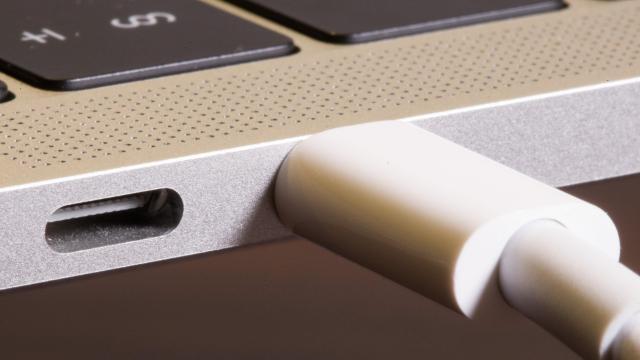Do you want to be chained to an outlet for the rest of your life? Of course not. That’s why you got a laptop in the first place. Somewhere down the line, many of us got the idea that our laptops should always be plugged in to improve their performance. This is a myth that’s slowly killing your laptop. Once your laptop is charged, you need to unplug it, or you might be tethered to the wall forever.
Many laptops sit on a charger throughout the workday and all through the night. We don’t even think about it; we just plug in everywhere. We’re charging at work, at home, at the coffee shop – a collective addiction to a laptop at 100% battery. There’s nothing more frustrating than a laptop that can’t hold a charge, but your charging addiction may be accelerating the issue.
Keeping your battery at 100% all the time is the worst thing you could do for your computer, according to Kent Griffith, assistant professor at San Diego State. He researches battery degradation and says this fully charged state puts a ton of stress on your laptop.
“When your laptop battery is sitting in this worst condition – 100% charge – for weeks or months at a time, that can be pretty damaging to it,” said Griffith in a phone interview with Gizmodo. “So when you take it off and expect it to last for 8 or 10 hours, it might only give you half of what you expect because it degraded a lot during that time”
The optimal state for your battery, according to Griffith, is somewhere between 20% and 80%. He recommends charging your laptop fully and then unplugging it to run down throughout the day. You should let your battery sit in this “mid-range” zone for most of its life to prolong your battery’s performance.
The reason a laptop is under a lot of stress at 100% is due to its lithium-ion battery. It consists of two layers, one made of graphite and the other made of lithium cobalt oxide, with lithium ions passing between them. A fully charged battery looks like (mostly) all of the lithium ions in the graphite layer, releasing energy to your computer when passed into the lithium cobalt oxide layer.
It’s when hen there are too many lithium ions on one side that the battery gets stressed. It performs at its best when there’s roughly an equal number of lithium ions throughout the battery — AKA 50%. Griffith also notes that high-speed charging cables can ruin the integrity of your battery by transferring these lithium ions too quickly.
Origins of the Myth
You don’t need to look much further than your desk to understand where this myth comes from. So many of us have come to believe that our laptops should always be plugged in, and that’s probably due to your computer’s predecessor. The Mac, the PC, and all desktop computers before the laptop have been permanently plugged in.
This is flawed logic. Your laptop is not drawing energy from the wall outlet, like your desktop computer. Rather, it’s drawing energy from your battery. Meanwhile, your battery is kept in this high-stress state, doing lots of little recharges between 99% and 100%.
Another reason folks may be “perma-charging” is so their computer never dies, and I hear you. Even though letting your laptop battery drain out and charge back up is healthier for your battery, it’s not as convenient. With a permanently plugged-in laptop, you can always jump on the go with a fully charged battery.
But over the long term, this doesn’t work as well. For an older laptop that’s been perma-charging, you may have a fully charged battery, but that full charge won’t get you as far. The newest M3 Macbooks from Apple tout 18-hour battery lives, but poor charging practices over the years could cut that in half.
Permanently charging your laptop is not a way to optimize performance, it’s actually quite the opposite. Nevertheless, laptops are plugged in constantly.
Why It’s Pervasive
The reason laptop “perma-charging” is pervasive is twofold. For one, it feels like it should be true. You want to get the most out of your computer, so giving it a direct line to a power source seems like the best way to get power. But that’s not really what’s going on.
The other reason is that most people are rarely using their computers away from the desk. It’s just easier to not think about it, and keep your laptop plugged in always, much like you would a desktop.
The problems start when you leave your desk. You head on a trip, on the train, to a coffee shop sparsely populated with outlets. Suddenly, your weak battery is the most noticeable feature of your laptop.
There’s much more discussion about battery life around smartphones, but I’d argue this is less of an issue due to their optimized charging features. iPhones will learn your charging patterns, slowing down charging speeds overnight so your phone spends minimal time at 100%. This feature is incredibly helpful for smartphone users, who typically just charge their phones when they sleep.
NewWindows and Apple laptops have these same optimization features, but they’re still not a perfect solution if your laptop is charging 24/7. The optimizers just slow down your battery’s charge to 100%, it doesn’t help you once it gets there. A good solution is just plugging in your laptop overnight with optimized battery charging, but remember, you gotta unplug throughout the day.
So the responsibility to care for your battery falls on you. Lithium batteries will naturally degrade over time, but you can do a lot to get more life out of your computer. Stop charging your laptop past 100% today, so you can free yourself from being plugged in tomorrow.
